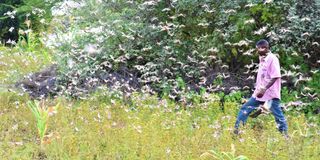Over 2,000 Isiolo households benefit from WFP anti-hunger scheme

A farmer walks in his farm amid an invasion by a swarm of locusts in january 2021. Over 2,000 households in Isiolo have benefited from the World Food Programme’s cash transfer programme.
When swarms of desert locusts invaded northern Kenya counties two years ago, devouring crops and vegetation, the livelihoods of a majority of the predominantly pastoralist residents were threatened.
And as national and county teams battled the ravenous pests, the survival of thousands of animals hung in the balance as pasture was depleted.
Then, Covid-19 struck Kenya in March 2020, and nearly a month and a half later, Isiolo County reported its first case.
Then, a few months after the suppressed March-May rains, drought struck, further worsening the woes of the arid and semi-arid counties.
Besides disrupting residents' economic activities, the drought, locusts and Covid-19 exposed locals to great suffering, with the majority of them unable to fend for themselves and their families, let alone pay school fees for their children.
Mr James Lesingiran, from Longopito village in Oldonyiro ward, lost several of his cows during the locust invasion.
Pastures destroyed
“The pests wreaked havoc on the pastures, dealing a huge blow to our livestock. The animals, due to lack of pasture, started feeding on the dead insects and remaining grass, resulting in emaciation and death,” Mr Lesingiran said.
Like other pastoralists across the region, he would trek for several kilometres in search of pasture for his dying cows amid growing competition for the remaining resources.
That competition sparked conflicts between Isiolo herders and those from neighbouring counties, resulting in loss of property, theft of animals and killings across the county.
Among the wards hit hard by locusts and crop failure were Oldonyiro, Chari and Kinna.
“Life was difficult for me and my family and often we slept on empty stomachs and help was so hard to come by,” Mr Lesingiran recalled.
Isiolo is among the counties hit hardest by drought, according to data from the National Drought Management Authority. Others are Mandera, Samburu, Turkana and Garissa.
Cash transfer programme
Luckily, Mr Lesingiran was among 2,200 households of six people each that benefited from the World Food Programme’s cash transfer programme rolled out two months ago.
“The Sh5,000 monthly assistance came in handy and enabled me to buy food and pay part of my son’s school fees,” Mr Lesingiran told Nation.Africa.
The assistance was a miracle for Ms Saadia Ibrahim, a mother of nine from Garbatulla, who says she used to rely on help from her neighbours.
“The Sh10,000 I got in July and August helped me clear some debts and buy food and I saved some of the money,” she said.
Ms Fatuma Guyo, another beneficiary, called for the assistance to be extended until the drought ends.
“There is a need for the aid to be extended to cushion us from the harsh economic effects of Covid-19 and drought,” the mother of six said.
Mr Felix Oketch, WFP officer in charge of refugee and relief operations in Kenya, said they will engage other partners for funding so as to extend the cash transfer programme.
Extend support
“We are holding talks with other partners with a view to extending the support to enable the vulnerable families to beat the challenges and to reach more beneficiaries,” he said.
The remaining 200 households who did not benefit, he said, had data entry issues but will get their money once the issue is rectified.
Garbatulla Central Location Senior Chief Mohammed Abdullahi Dika said similar interventions are needed for other needy residents.
“A lot of our people are affected and are food-insecure and, therefore, need several partners to come on board and assist them,” the administrator said, adding that the situation is worsening by the day.
The local community helped in identifying vulnerable families before their names were validated.
The chief said the majority of residents were hungry and were selling their emaciated animals at throwaway prices in order to buy food.
The Food Agriculture Organisation late last year undertook a similar Sh40 million programme to cushion residents in Samburu, Isiolo, Garissa and Tana River against the effects of the locust invasion, Covid-19 and crop failure.
Each of the four counties received Sh10 million, with each of the 1,000 households in Isiolo getting Sh10,000.





